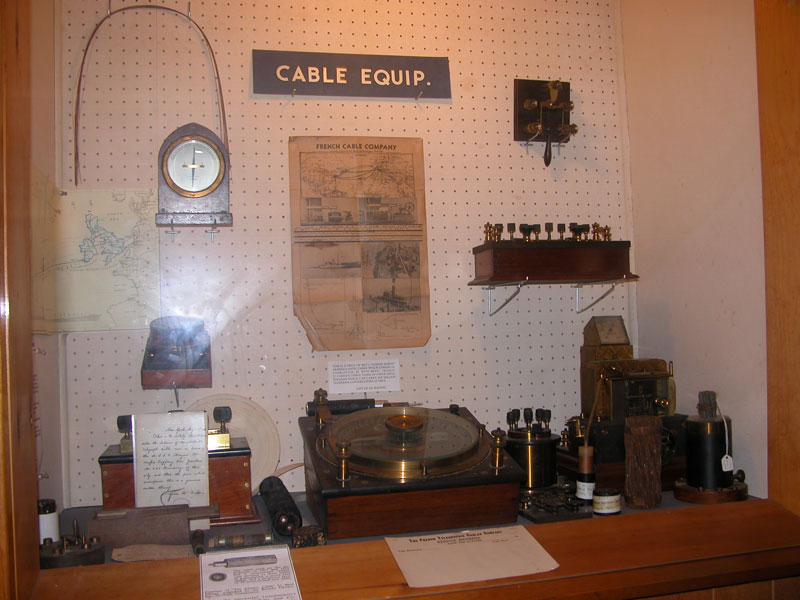Tragically, the first cable only lasted for about a day, but Cyrus Field didn’t give up, and he arranged to lay another cable. To raise money for the laying of the cable, he had Tiffany’s of New York, package sections of the old cable, and strapped them in brass, and sold them at a good dollar to collectors. Those are several versions of the Tiffany cables that were sold to raise money for the second transatlantic cable.
Fred – “This is a French telegraph. Is that Field?”
We have more than just Cyrus Field here. The French telegraph came ashore at Orleans (Massachusetts) on Cape Cod…
Fred – “That was a separate cable altogether.”
Oh, completely, and many years later. They had an office in New York. It came ashore on the outside of Cape Cod, and was carried across Cape Cod to Orleans, and from Orleans it was carried on pole lines to New York City, where their headquarters was, on this side of the Atlantic.
Cable communication in the early days of course was all telegraph. Telephone hadn’t come around. Alexander Graham Bell was not in the picture yet.
But, in order to maximize the signal over thousands of miles, they had to use a double-key system, plus and minus 150-volts or a difference of 300 volts. You see this little telegraph key here with two paddles? One of them puts a negative polarity on the conductor. The other one puts a positive polarity on the conductor, so you had to key it in this manner. That was to achieve long distance all the way across the Atlantic. Because, what you wound up at the end with was a small fraction of milliamperes. A very, very faint signal. Now, as time progressed…
Fred – “Well, being under the ocean, did sunspots or lightning storms affect transmissions?”
Well, sunspots in particular, because they would change the potential from one end of the Atlantic to the other. You’d have a potential difference, and they could cause drastic problems, superimposed on the feeble signal.
There are pieces of other people’s cables. That thing that looks like an ice cream torte there, sliced off, is a piece of the English cable. This came across at Plymouth, Massachusetts.
Here’s a coaxial cable, single-conductor coaxial cable, and by advancing to, more or less contemporary, on the pegboard in the back, the gift of Ed Rooney…you see a piece of the modern fiber optic cable. And if you read that label, “This is a piece of MCI’s Gemini North Transatlantic Cable which connects Charlestown, RI with Brest, France. It carries three pairs of fiber optic strands which can carry six million telephone conversations at once.”…as well as television pictures.
In the center of that…these fiber optic strands…see them hanging on the pegboard? That’s what’s in the middle of that cable. Each one of those strands can carry a separate signal.
Fred – “And just think, for however many thousand miles, that can’t have any imperfection in it.”
You have to be very, very careful about injuries to it.
And that cable, which is the Verizon cable, goes to Bermuda, and from Bermuda it goes over to France.
Text from the transcript of a tour of New England Wireless & Steam Museum’s Wireless Building given by Robert W. Merriam on a winter day in 2012. Transcription by Craig H. Moody, K1CHM. Edited by Fred Jaggi.
